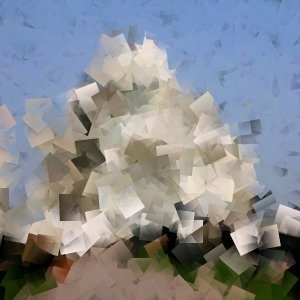| 11.4. Kubismus | ||
|---|---|---|

|
11. Künstlerisch |  |
Abbildung 17.203. Anwendungsbeispiel für das Filter „Kubismus“

Originalbild

Filter „Kubismus“ angewandt
Dieses Filter verändert das Bild so, als wäre es aus vielen kleinen quadratischen, halbtransparenten Stücken Seidenpapiers zusammengesetzt.
![[Tipp]](images/tip.png)
|
Tipp |
|---|---|
|
Wenn Ihnen die Einstellungsmöglichkeiten dieses Filters nicht genügen, schauen Sie sich das Filter GIMPressionist an. Mit diesem können Sie ähnliche Effekte erzeugen, allerdings bietet es Ihnen eine größere Fülle von Eigenschaften und Variationsmöglichkeiten. |
![[Anmerkung]](images/note.png)
|
Anmerkung |
|---|---|
|
These options are described in Abschnitt 2, „Gemeinsame Funktionsmerkmale“. |
Diese Eigenschaft des Filters bestimmt die Größe der Quadrate, aus denen das Bild zusammengesetzt wird. Die Einstellung können Sie über einen Schieberegler oder das zugeordnete Eingabefeld im Bereich von 0,0 bis 100,0 Pixel vornehmen.
This variable specifies how intense the color of the squares should be. This affects the opacity of the squares. A high value will render the squares very intensely and does not allow lower squares to show through. A lower value allows the lower squares to be more visible through the higher ones and causes more blending in the colors.
This allows you to change the background color that is used by this filter. You can click the color bar to select a color, or use the color picker to pick a color from your image.
The randomness in this filter is based on a so-called seed. Different seeds will cause the output of the filter to change. You can change the seed until you find a preview that you like.
![[Tipp]](images/tip.png)
|
Tipp |
|---|---|
|
If you are using this to generate background images for web pages and the like, work with a small range of colors painted randomly on a small square. Then apply the Cubism filter with the desired settings. As a last step, try Tile Seamless to adjust the image so it will tile seamlessly in your background. |